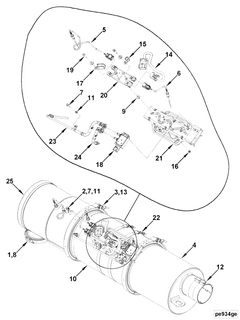This truck part is made by Cummins®. We guarantee that all of our parts are from the OEM (original equipment manufacturer), ensuring a proper fit and quality manufacturing.
We honor the warranty provided by the original equipment manufacturer.
Introduction
The Cummins 5283209 Aftertreatment Device is engineered for commercial trucks to reduce emissions and enhance engine performance, ensuring compliance with environmental regulations. This device is integral to minimizing the environmental impact of diesel engines.
Basic Concepts of Aftertreatment Devices
Aftertreatment devices are installed in vehicle exhaust pathways to reduce pollutant emissions. They filter harmful substances from exhaust gases before release, integrating seamlessly with the engine for optimized performance and emissions control 1.
Purpose of the Cummins 5283209 Aftertreatment Device
This Cummins part processes exhaust gases to remove pollutants like nitrogen oxides (NOx) and particulate matter (PM), enhancing engine performance and ensuring compliance with environmental regulations by lowering emission levels 2.
Key Features
The Cummins 5283209 Aftertreatment Device features a robust design and high-quality materials for durability and efficiency. It incorporates advanced filtration media and precise engineering to enhance functionality, contributing to its effectiveness in reducing emissions and improving engine performance 3.
Benefits
Using this Cummins part offers advantages such as improved fuel efficiency through optimized engine operation, reduced maintenance costs due to durable construction, and enhanced exhaust system durability, leading to longer service intervals and reduced downtime.
Integration with Other Systems
The Cummins 5283209 Aftertreatment Device interacts with various truck components, including sensors, control modules, and diagnostic tools, to monitor and adjust the exhaust treatment process, ensuring efficient and effective operation 4.
Common Issues and Troubleshooting
Typical issues with this Cummins part include filter media clogging and sensor malfunctions. Troubleshooting involves inspecting for blockages, cleaning or replacing filters, and checking sensor readings. Solutions often include routine maintenance and timely component replacements.
Maintenance Practices
Regular maintenance is recommended to ensure the longevity and optimal performance of the Cummins 5283209 Aftertreatment Device. This includes periodic inspections, cleaning to remove particulates, and adhering to replacement schedules for filters and consumable parts.
Environmental Impact
The Cummins 5283209 Aftertreatment Device significantly reduces harmful pollutant emissions, contributing to cleaner air quality and mitigating the environmental impact of commercial trucking operations. It plays a role in reducing the carbon footprint of the transportation sector.
Technological Innovations
This Cummins part incorporates technological innovations, including patented technologies and unique design elements, enhancing its efficiency and reliability. These advancements ensure it meets the demanding requirements of modern commercial trucks, reflecting Cummins’ commitment to innovation.
Cummins Overview
Cummins Inc. is a leading manufacturer of diesel engines and related technologies, dedicated to enhancing engine performance, reducing emissions, and improving fuel efficiency. The company’s commitment to sustainability is evident in its product offerings, including the Cummins 5283209 Aftertreatment Device.
Role of Part 5283209 Aftertreatment Device in Engine Systems
The integration of part 5283209, an aftertreatment device, into engine systems enhances overall efficiency and environmental compliance. This component works with several other systems to ensure optimal performance and reduced emissions.
Exhaust Gas Recirculation (EGR) System
The aftertreatment device interfaces with the EGR system to manage the recirculation of exhaust gases, reducing the formation of nitrogen oxides (NOx) and ensuring they meet emission standards before release.
Diesel Particulate Filter (DPF)
The aftertreatment device often includes or works closely with the DPF to capture particulate matter from exhaust gases. It may incorporate sensors and control units that monitor the DPF’s performance, facilitating timely regeneration processes.
Selective Catalytic Reduction (SCR) System
The SCR system relies on the aftertreatment device to inject urea (DEF) into the exhaust stream, converting NOx into harmless nitrogen and water vapor. The device ensures precise dosing of urea, optimizing the reduction process.
Oxygen Sensors
Oxygen sensors provide real-time data on oxygen levels in the exhaust gases. The aftertreatment device uses this information to adjust the air-fuel mixture and ensure catalytic converters operate within their optimal range.
Engine Control Unit (ECU)
The ECU communicates with the aftertreatment device to monitor and control various parameters such as temperature, pressure, and emissions levels, allowing for dynamic adjustments to the engine’s operation.
Turbocharger
The turbocharger’s role in increasing engine efficiency is complemented by the aftertreatment device, which ensures that the exhaust gases are clean and within regulatory limits, allowing the turbocharger to operate more effectively.
Cooling System
The aftertreatment device may interact with the engine’s cooling system to manage temperatures within the exhaust stream, ensuring the efficient operation of aftertreatment components.
Conclusion
The Cummins 5283209 Aftertreatment Device is a pivotal component that enhances the functionality and environmental performance of engine systems through its integration with various other components. Its role in reducing emissions and improving engine performance underscores the importance of aftertreatment technologies in modern diesel engines.
-
Bennett, S. (2012). Modern Diesel Technology: Light Duty Diesels. Cengage Learning.
↩ -
Bosch, R. (2007). Bosch Automotive Electrics and Automotive Electronics: Systems and Components, Networking and Hybrid Drive 5th Edition. Springer Vieweg.
↩ -
Miedema, S. A., & Lu, Z. (2010). The Dynamic Behavior of a Diesel Engine. Published by Drir S. A. Miedema.
↩ -
Cummins Inc. (n.d.). Fault Code Troubleshooting Manual. Bulletin Number 5659673, QSK60 CM2150 MCRS.
↩
RECOMMENDED PARTS
* Variable geometry turbocharger and electronic actuator repairs are not eligible to be claimed as over-the-counter under New or ReCon parts warranty for parts installed after October 1, 2018.
* Diesel Oxidation Catalyst (DOC), Diesel Particulate Filter (DPF), Selective Catalyst Reduction (SCR) catalyst, and Electronic Control Module (ECM) repairs are not eligible to be claimed as over-the-counter under New or ReCon parts warranty for parts installed after January 1, 2020.
* These restrictions are only applicable to New parts and ReCon parts coverages for the components listed above sold to a customer in the US or Canada. All other coverages are excluded. All other regions are excluded.

